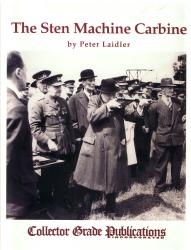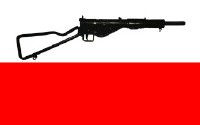 |
Polish Underground Sten Gun Production During World War Two | 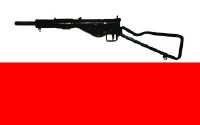 |
|
|
|
|
Firearms Technical Trivia, October 2000:
 |
Polish Underground Sten Gun Production During World War Two |  |
The Sten 9x19mm submachine gun, so named for the initials of its designers and the name of the factory where it was developed (Shepherd Turpin ENfield), is one of the ubiquitous weapons of the Second World War. No picture of Commonwealth forces in action from 1942 onwards is complete without the Sten's tubular profile and horizontal magazine featuring prominently. Born of a need for a simple and cheap to produce weapon that would be reliable and well suited for close work, the Sten served the British admirably until 1957. However, the Sten was also the standard for resistance groups in occupied Europe. Many were air dropped to resistance groups from France to Greece to Poland. Many of the resistance groups actually set up clandestine factories to produce Stens under the very noses of the Nazi occupiers. In this month's Technical Trivia, we will endeavor to touch upon the highlights of Sten gun production in occupied Poland during the war.
During the 1930's, Polish military literature evidenced significant interest in the use of submachineguns (SMG's) in contemporary conflicts such as the Chaco War between Paraguay and Bolivia from 1932 to 1935, and the Spanish Civil War from 1936 to 1939. Universally, these writings praised the performance of the portable automatic weapons in those conflicts. Despite this professional interest, the Polish military invested very little in SMG procurement or development. Small numbers of M1921 Thompsons and M1931 Suomis were ordered in 1936, but these procurements never numbered more than 200 guns. In that same year an indigenous SMG development program was begun. Three years later, this program yielded a prototype which was dazzling in its complexity. It featured a quick change barrel, a dual trigger mechanism (one for semi, one for full auto), a pneumatic rate of fire reduction mechanism, a last shot hold open device that also automatically released the magazine, and a monopod within the forward pistol grip. In the event, only about fifty of these marvels were ever made.
Thus, the Polish Army went to war in September, 1939 all but devoid of SMG's. While this lack of mobile firepower certainly wasn't the critical factor in the Poles' rather ignominious defeat at the hands of the Wehrmacht, it certainly didn't help matters. After the defeat, a number of underground resistance organizations arose, each with its own military wing. Eventually, most of these organizations (save for the communists) found their way into the Zwiazek Walki Zbrojnej, or Union for Armed Struggle. Shortly after its formation, the Union for Armed Struggle became the Armia Krajowa, or Home Army. The communists, under the guise of the Polish Worker's Party also organized their own military units. These were first referred to as the Gwardia Ludowa, or the People's Guards, and later the Armia Ludowa, or People's Army. The communist organizations do not feature prominently in our story as most lacked any capability to produce their own weapons, much less decent copies of the Sten gun.
The lessons of the Blitzkrieg were not lost on the Polish underground. As the fledgling resistance groups began to organize, they attempted to secure every available SMG. This was more difficult that one might expect, as, contrary to Hollywood portrayals, not every German soldier's kit included an MP38 or an MP40 (the "Schmeisser"). Actually, the MP40 was rarely seen in Poland, which, until 1944, was deep in the German rear area, and the few German police units that boasted SMG's were using MP18,I's, MP28's, and a smattering of Erma EMP's and former Austrian MP34(o)'s. Since Allied air drops of war materiel would not begin until late 1943, the only route available to the resistance movement to procure SMG's was to begin their own clandestine manufacturing programs.
These underground manufacturing programs achieved remarkable success, and are conservatively estimated to have produced more than 1,300 SMG's based more or less on the Sten design. These guns spanned the spectrum from crudely made local designs hand made by village blacksmiths to small runs of provincial "lookalikes", to high quality copies made by skilled industrial workers. In Warsaw alone there were several factories engaged in producing Sten copies, some of which produced hundreds of guns. The following list highlights the details of Polish Sten production:
Sypniewski
Agricultural Machinery Plant, 97 Mogilska Street, Cracow
Jerzy Sypniewski
and Dominik Jura established "Factory Number 5" to produce firearms for
the local Home Army units. The underground factory made several hundred
high quality Sten copies between 1943 and April 1944. In April 1944
the factory was raided by the Gestapo and Dominik Jura was tortured to
death.
Herzfeld-Victoria
Metal Plant, Konskie
During the
summer of 1944 underground operatives working under the supervision of
Wladyslaw Slowinski at this plant made approximately fifteen Sten lookalikes.
Durakiewicz
Stens, Markuszow
Julian Durakiewicz
made several Sten copies rechambered for an unknown pistol caliber cartridge
(7.65mm Browning? 9mm Browning Short?).
Liquidators,
Opatow
Between April
and July 1944, the Home Army's Zygmunt Dydo made eight smoothbore Sten
lookalikes that lacked stocks and had integral pistol grips, to which he
gave the name "Liquidators."
Radom Factory
Stens, Radom
Two members
of the Polish Socialist Party's Military Organization, Edward Szulmajer
and Adam Chaberko, made approximately twelve Sten copies. Parts for
these guns were made in various workshops by Radom factory employees.
This same group also assembled clandestine copies of the Vis (Radom) pistol,
made from parts stolen from the factory. The German reaction to this
activity was to move the assembly work to Steyr, in Austria, and then closing
down the barrelmaking line. This way, they reasoned, any stolen guns
would not have barrels. This worked for about eighteen months until
an underground barrel making factory was established in Warsaw.
Mijal Stens,
Rawa Mazowiecka
Antoni Mijal
made seven Sten lookalikes in his blacksmith shop during 1943 and 1944.
Nawrocki
Stens, Skarzysko-Kamienna
Marcin Nawrocki,
one of the Home Army's armorers, made sixteen or eighteen Sten parts kits
with smoothbore barrels. Ten of these guns were refitted with Warsaw
made rifled barrels in 1943.
KIS Parts
Kits, Starachowice
Between November
1943 and summer 1944, a group including Polikarp Rybicki, Witold Szafranski
and Stanislaw Skorupka made 37 parts kits for a simplified Sten lookalike
called the KIS at a base in the Swietokrzyskie Mountains. The KIS
lacked a stock and had an integral pistol grip. Unlike the Sten,
it had no barrel nut. The barrel was thick at the breech end, tapering
toward the muzzle.
Stanislas
Tanski Industrial Works Stens, Suchedniow
A very successful
mass production run of Stens was organized by Kazimierez Czerniszewski.
These guns were of a very high quality. By the end of August 1943,
four guns had been assembled, and parts sets for 100 more were ready.
Witnesses recall the finish on these guns as being much better than on
the British guns that had been air-dropped to the resistance. Several
more batches of parts were provided, and some forty more guns were built
before the Gestapo, alerted by a collaborator, raided the factory in October
1943. Mr. Czerniszewski fled to Warsaw, where he helped the Home
Army to organize other Sten factories until his arrest in December 1943.
Six months later, he was deported to a death camp, and against all odds,
managed to survive the war.
Konrad Jarnuszkiewicz Metal Factory "Sten PM's," Warsaw
| By far the best of all the Polish Sten copies, this was an exact copy of the Mark II Sten gun made under the supervision of Jozef Kapler. The factory turned out at least 180 parts kits including rifled barrels from late 1943 |

Image Credit: Laidler, Peter, The Sten Machine Carbine, Collector Grade Publications, Cobourg, Ontario: 2000 Page 192 |
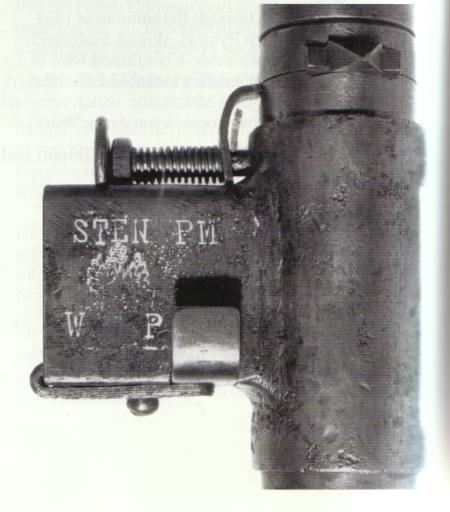
Image Credit: Laidler, Peter, The Sten Machine Carbine, Collector Grade Publications, Cobourg, Ontario: 2000 Page 192 |
through
August 1944. Several of these survived the war, including one on
display at the Polish Military Museum. These copies were so sophisticated
that they included the inscription "Sten PM" on the top of the magazine
housing. (PM stood for Pistolet Masznowy or machine pistol),
with a coded serial number on the underside of the housing. Polish
eagles were stamped on the top of the magazine housing, trigger mechanism
cover, and on the handplate at the front of the stock.
(These stampings were accomplished with the aid of a die which had previously been used to mark the cash boxes used by the pay officers in the pre-war Polish Army.) |
686 Ordnance
Platoon Stens, Warsaw
Two Home Army
ordnance technicians of the 686 Ordnance Platoon, Stefan Jakubowski and
Henryk Dutkiewicz made between 111 and 180 Sten copies at workshops
located at 138 Grochowska Street in Warsaw and in rooms on the ground level
of the Royal Castle in Warsaw. The magazine housings of these particular
Stens were welded to the receiver casings.
 |
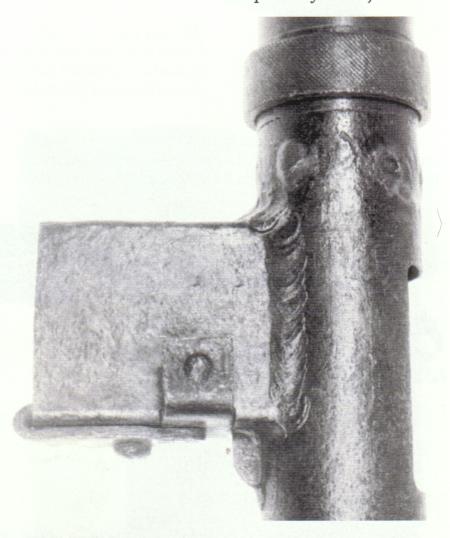 |
Dubak/Wyganowski
Parts Kits, Warsaw
Messrs. Jerzy
Dubak and Tadeusz Wyganowski made approximately forty Sten parts kits in
workshops located at 34 and 67 Aleje Jerozolimskie in Warsaw.
Widan Metal
Works Parts Kits, Warsaw
Approximately
500 Sten parts kits were manufactured at this facility by Witold Daniszewski
between autumn 1943 and July 1944. The kits were distributed to various
assembly throughout Warsaw and the rest of Poland.
Stepniewski
Parts Kits, Warsaw
Starting in
1943, Feliks Stepniewski made approximately 65 Sten parts kits in a workshop
at 27 Przyokopowa Street. Of these, some 40 were accepted by the
Home Army before the Gestapo raided the factory in June, 1944.
KOP/PAL
Buttless Stens, Warsaw
A total of
approximately 100 of these buttless Sten copies were made up by Edward
Wloczkowski and Stefan Nawrocki for the Komenda Obroncow Polski/ Polska
Armia Ludowa (Headquarters of the Defenders of Poland/Polish People's
Army) KOP/PAL resistance organization in a workshop at 1 Gniewskowska Street.
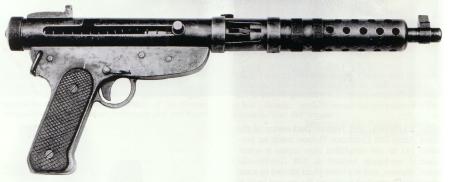 |
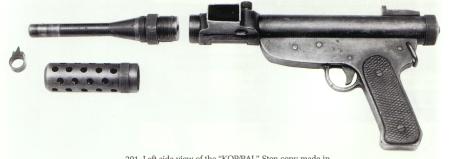 |
The KOP/PAL guns were "discovered" in 1976. Inside a wood stove in a house being demolished on Lelechowska Street in Warsaw were drawings and plans for the buttless Sten copy, along with five barrels. When this was publicized, former resistance cell members involved in the production of these guns came forward and supplied details of the guns' production, including that they had been designed by Stefan Engler and Michel Adamowicz.
Czajkowski
Barrel Works and Sten Assembly Plant, Warsaw
Teofil Czajkowski's
Metal Workshops at 18 Leszno Street were not actually Sten manufacturers,
but made high quality rifled barrels for a number of 9x19mm weapons, to
include Sten copies and Radom pistols. Czajkowski barrels were distributed
to Sten assembly plants all through occupied Poland. In the months
immediately preceding the Warsaw Uprising in August 1944 a Sten assembly
plant was established at the 18 Leszno Street facility. A total of
200 parts kits of varying manufacturers were assembled prior to the uprising,
with another 25 being completed before the factory was bombed out on August
25, 1944.
The Blyskawica
| In addition to the Sten copies, some 700 to 900 examples of an indigenous SMG design called the Blyskawica, or Lightning were made in Warsaw in 1943 and 1944. The Blyskawica had a rifled barrel, a permanently affixed folding stock with a cast alloy buttplate and a |
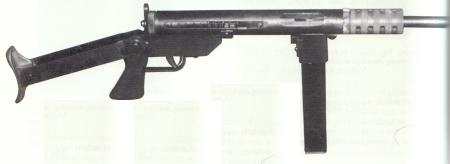
Image Credit: Laidler, Peter, The Sten Machine Carbine, Collector Grade Publications, Cobourg, Ontario: 2000 Page 198 |
Conclusion
The Polish
Underground produced more Sten copies than any other European Resistance
movement during the Second World War. Despite this, very few of these
Polish Stens survived the war; testament to the Home Army's (and other
Polish resistance groups') high mortality rate for both men and equipment.
Many of the names of the manufacturers and the history of the guns they
made were only discovered years after the war as a result of careful and
methodical research by historians of the Polish Army Museum. An anecdote
illustrates the serendipitous nature of this research:
Postwar research related to the Sten Mark II copies made at the Jarnuszkiewicz Metal Factory in Warsaw, a previously unknown group of Sten copies with permanently welded magazine housings were founds. This critical difference suggested that the guns were made by a different factory. In 1994 the head of the Firearms Department of the Polish Army Museum, Roman Matuszewski was approached by Stefan Jakubowksi with a request for pictures and plans of Sten guns to be used in the design of a memorial plaque to be used as part of a memorial to a previously unknown Underground arsenal. Mr. Jakubowksi described the procedures he had used to manufacture the Stens he produced: The thin walled tube template used for drilling the series of holes which were later joined and smoothed to form the cocking handle slot, magazine and ejection openings, and the use of a second template to form the magazine housing box which was then welded directly to the receiver tube. Somewhat taken aback, Mr. Matuszewski thought that the guns Mr. Jakubowski was describing might in fact be the Sten copies of unknown origin which had recently been acquired.
And so, Mr. Matuszewski brought out three Stens to show Mr. Jakubowski: An original, air-dropped British Mark II, a Jarnuszkiewicz copy, and one of the unknown guns with the permanently welded magazine tube. Mr. Jakubowski immediately identified the last as coming from his clandestine workshop and began to tell Mr. Matuszewski the details concerning the operations of this particular workshop. In 1941, after harrowing two years since the German- Russian invasion of Poland, Mr. Jakubowski had joined the Home Army and had obtained a new identity as "Stefan Gudzillo," as well as the codename "Mir." He then established metalworking shops in the ground floor rooms of the Royal Castle in Warsaw, producing such items as hair clips, candelabra, and toys so as
| to mislead any collaborators and the Germans. In 1942 a Home Army agent known as "Szary" approached him with a request to produce weapons. With the assistance of another Home Army agent known as "Pilot," and using an air- dropped British Sten as a template, they produced the necessary plans and blueprints for the production of Sten copies. Barrels were delivered from an outside source. Tubing for the receivers and magazine profiles were obtained from a pipe works owned by a Mr. Minkiewicz, and the cutting, drilling, and production of external parts was done at the Royal Castle workshop. Magazine followers were made at the locksmith |
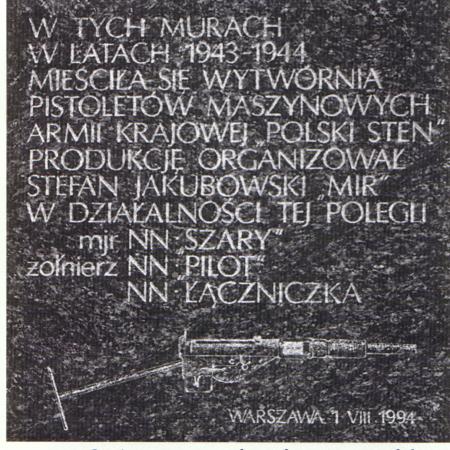
Image Credit: Laidler, Peter, The Sten Machine Carbine, Collector Grade Publications, Cobourg, Ontario: 2000 Page 202 |
In 1944, after approximately 180 guns and 300 magazines had been completed, "Szary" had to shut down the Royal Castle operation when it was betrayed by a collaborator. Production was never resumed.
This account was happily verified in 1994 when Home Army veteran Henryk Dutkiewicz, then living in Australia, returned to Poland for a visit. While touring the Polish Army Museum, Mr. Dutkiewicz asked about Stens he had helped to produce in an underground arsenal on Grochowska Street, noting that they had been made in cooperation with a group operating out of the Royal Castle. Mr. Matuszewski immediately contacted Mr. Jakubowski and had the pleasure of reuniting the former resistance fighters for the first time in fifty years.
Like the Liberty Ships that plied the oceans delivering valuable war materiel to allied forces all over the globe, the Stens were neither pretty nor elegant. Despite this, they served well in the struggle against German and Japanese forces during the Second World War. The example of the Polish Underground, while prolific, was not unique. Stens were produced all over the world, and used to good effect. This ugly duckling, often derided, should earn a place in the pantheon of firearms that have come to symbolize human struggle against oppression. Indeed next to the muskets of the Minutemen at Lexington and Concord, the Mausers carried by the Boers, the Kalashnikovs used in countless colonial wars, and the Enfields that armed the Afghan fighters in their struggle to oust the Soviet invaders, the Sten should take its rightful place.
Note: Data for this month's trivia page was gathered from:
The Sten Machine Carbine, by Peter Laidler, Collector Grade Publications, 2000
The Sten
Machine Carbine is available from Collector Grade Publications.
Click on the image to order.
